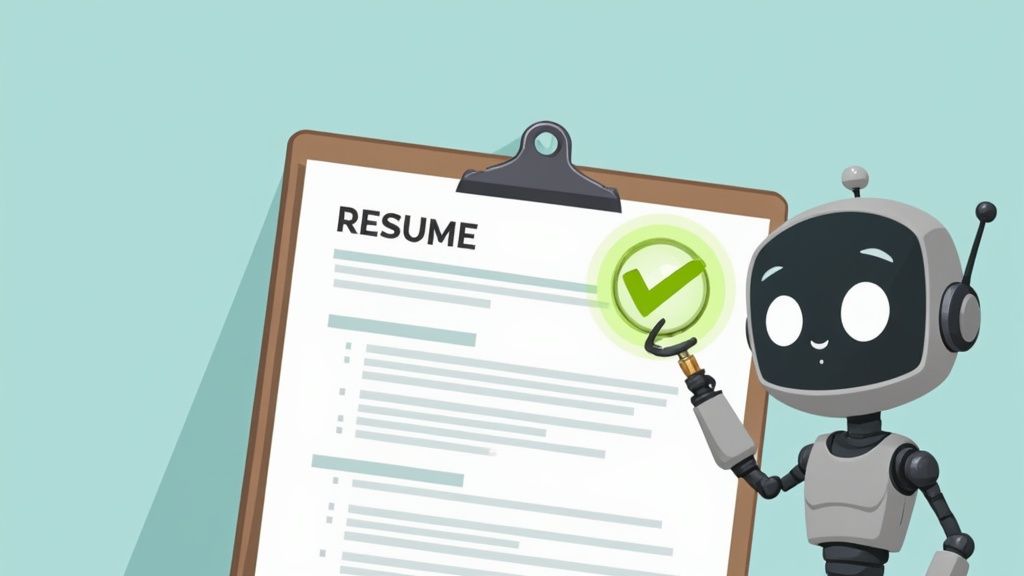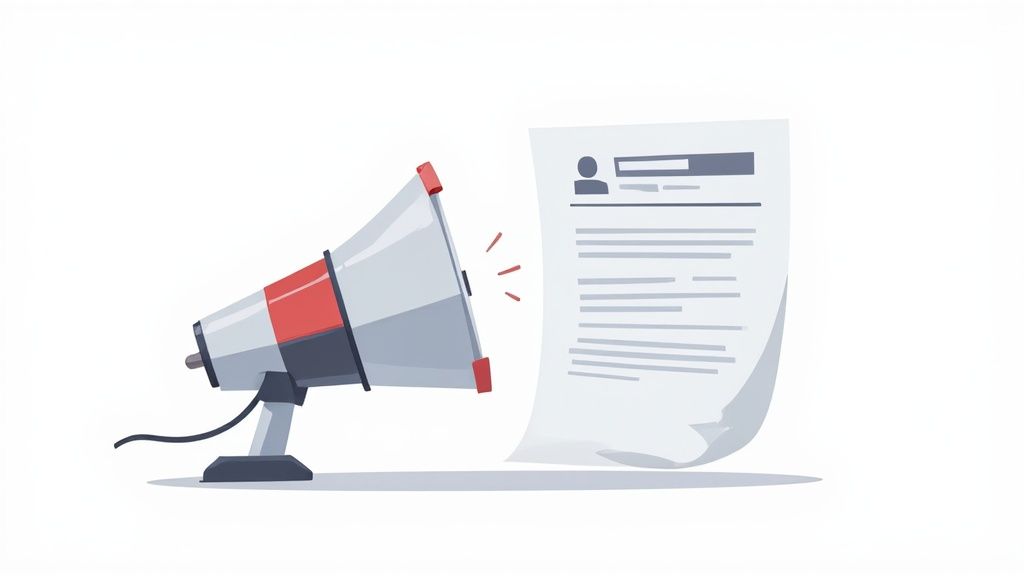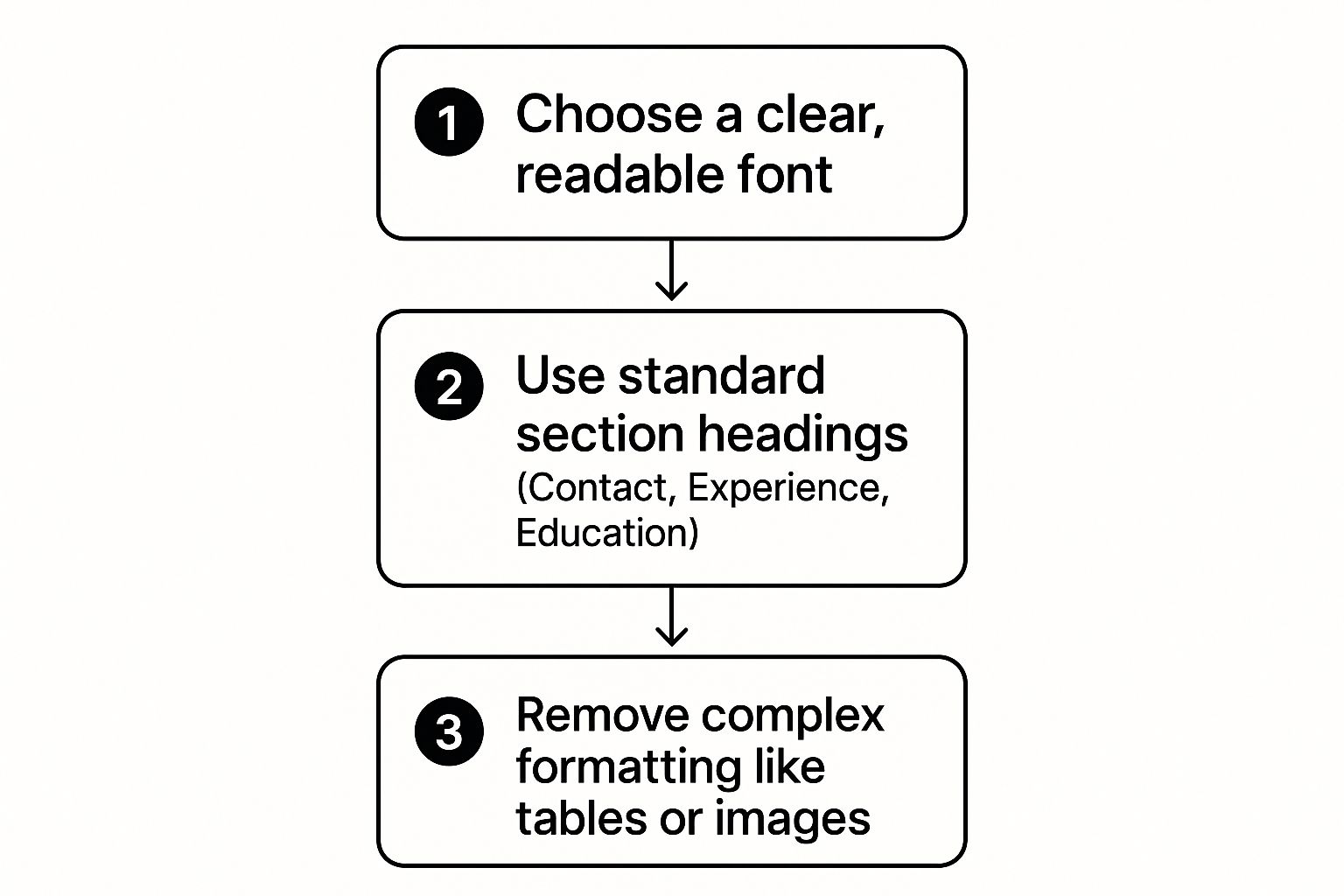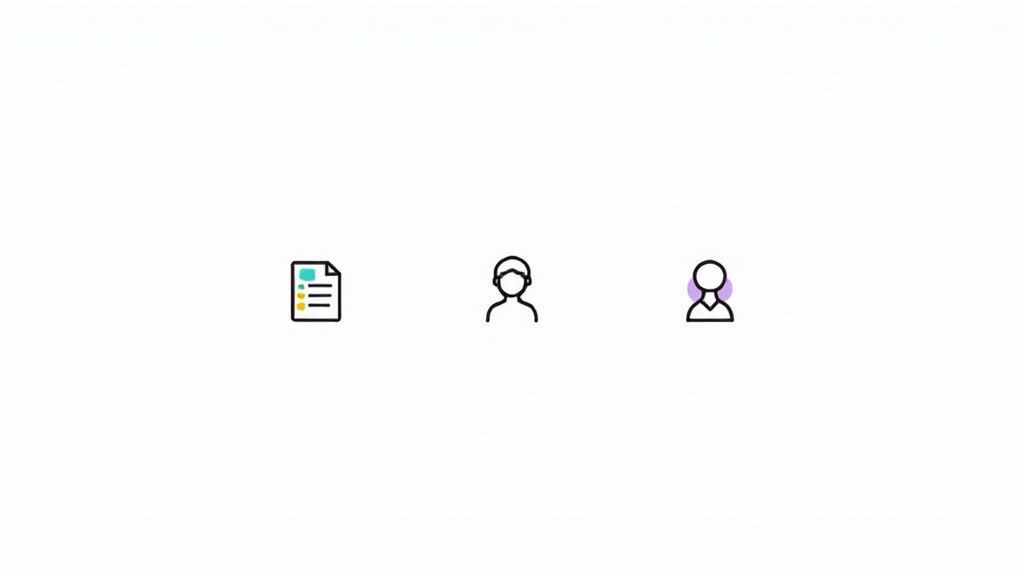
Your Guide to an ATS Friendly Resume Template
An ATS-friendly resume template isn’t just a document; it’s a key that unlocks the first door in the hiring process. It’s a resume built with a clean, simple format specifically so that Applicant Tracking Systems (ATS) can read and understand it without a hitch.
These software systems are the new gatekeepers. They scan your application for keywords, skills, and experience long before a human recruiter ever lays eyes on it. If your resume can’t pass this initial digital screening, it gets tossed into a virtual “no” pile, no matter how perfect you are for the job.
Why Your Resume Needs to Impress a Robot First

Before your resume ever has a chance to impress a hiring manager, it has to get past that digital gatekeeper. This first hurdle is the Applicant Tracking System (ATS), the software that nearly every company uses to manage the flood of applications they get for every open role.
Think of it as a bouncer for your resume. If your document isn’t on the list—meaning, if it isn’t formatted correctly—it’s not getting in.
And this isn’t some niche tech used by a few companies. It’s the standard. Current data shows that a staggering 97.8% of Fortune 500 companies now rely on an ATS to filter their candidates. This means that for virtually every major employer, you must optimize your resume for a machine first. Getting this right is no longer just a good idea; it’s a non-negotiable part of a modern job search. If you’re curious about the specifics, you can find a full breakdown of how top companies use this technology.
How an ATS Scans Your Resume
An ATS doesn’t appreciate your creative flair or eye-catching design. It’s a machine that methodically breaks down your resume’s text to pull out specific data points and dump them into a digital profile.
The software is programmed to look for a few key things:
- Keywords and Phrases: The system is on a mission to find skills, job titles, and qualifications that directly match the job description. If the posting asks for “agile methodologies” and “stakeholder management,” the ATS is looking for those exact phrases.
- Standard Section Headings: It expects to see familiar headings like “Work Experience,” “Education,” and “Skills.” If you get creative with “My Professional Journey” or “Where I’ve Been,” you’ll confuse the software, and it might just skip over that whole section.
- Contact Information: The system needs to easily locate your name, phone number, and email. Hiding this info in a fancy header or footer is a common mistake that can make it completely invisible to some ATS programs.
The following table breaks down some of the most common formatting choices and shows why the “creative” route is often a dead end when it comes to the ATS.
ATS-Friendly vs. Creative Resume Formatting
| Feature | ATS-Friendly Approach (Recommended) | Creative Approach (Risky) |
|---|---|---|
| Layout | Single-column, linear flow. | Multi-column layouts, text boxes, or tables. |
| Fonts | Standard, web-safe fonts like Arial, Calibri, or Georgia. | Custom or script fonts that the ATS may not recognize. |
| Section Titles | Standard headings (e.g., “Work Experience,” “Skills”). | Unconventional titles (e.g., “My Story,” “Superpowers”). |
| Graphics | No logos, charts, or images. | Photos, skill-level graphs, or company logos. |
| Contact Info | Placed in the main body of the resume. | Placed in the header or footer section of the document. |
Ultimately, choosing a creative format might look great to you, but it’s a massive gamble. The ATS just sees a jumbled mess.
The Cost of an Incompatible Resume
One of the biggest mistakes I see job seekers make is confusing a beautiful resume with an effective one. All that complex formatting—the columns, tables, graphics, and funky fonts—can cause major parsing errors. When the ATS tries to read it, the information gets garbled, and your digital profile ends up incomplete or nonsensical.
When an ATS can’t read a resume correctly, it doesn’t just knock a few points off your score. More often than not, it discards your application entirely. A perfectly qualified candidate can get rejected for one simple reason: the software couldn’t make sense of their resume’s layout.
This is precisely why an ATS-friendly template is so critical. It strips away the fancy design elements to prioritize clarity and compatibility. You’re not trying to trick the system; you’re just learning to speak its language. Do that, and your experience will finally get the human attention it deserves.
Building a Clean and Scannable Resume Layout
The secret to a truly effective ATS-friendly resume template isn’t fancy graphics or clever wording—it’s the structure. Before you even get to keywords, the layout has to be clean, logical, and dead simple for software to read. Think of it as the foundation of a house. If it’s shaky, everything you build on top of it is at risk.
Your main job here is to make the document incredibly easy for a machine to understand. This means letting go of the visual frills and focusing purely on clarity. The best way to do this? A traditional, single-column format that flows straight down the page. This prevents the ATS from getting confused, which is a classic problem with two-column resumes. I’ve seen it happen: the software tries to read straight across the page, mashing up your job history with your skills section into an unreadable mess.
Selecting Compatible Fonts and Formatting
The font you pick matters a lot more than you might think. That cool script font might catch a human eye, but an ATS will likely just see it as gibberish. You need to stick with universally recognized, web-safe fonts. Your best bets are Calibri, Arial, Georgia, or Times New Roman. They’re boring, but they work every time.
Your formatting choices should follow the same logic: function over flair. Complex design elements are the enemy of an ATS-friendly layout. Be sure to avoid these common pitfalls:
- Tables and Text Boxes: People love using these to create neat columns, but they can completely scramble your text when an ATS tries to parse it.
- Images and Logos: Any graphic, from your headshot to a company logo, is basically invisible to the software. Worse, some systems will reject the file outright because of them.
- Headers and Footers: This is a big one. Never put critical information like your name or contact details in the header or footer. Many older systems are programmed to ignore those areas completely.
This graphic breaks down the core ideas behind a scannable resume structure.

As you can see, a few simple, strategic choices in fonts, headings, and overall formatting are all it takes to build a document that gets past the bots.
Structuring Your Sections Logically
How you name your resume sections is just as important as what you put in them. The ATS isn’t smart; it’s just programmed to look for standard, predictable headings to sort your information. Now is not the time to get creative. Stick to the classics.
Using a quirky heading like “My Professional Journey” instead of the standard “Work Experience” is one of the fastest ways to confuse an ATS. The software might not recognize your career history, effectively making your most important qualifications disappear.
Your resume should always follow a predictable order with these standard sections:
- Contact Information: Your full name, phone number, professional email, and a link to your LinkedIn profile.
- Professional Summary: Think of this as a keyword-rich elevator pitch right at the top.
- Work Experience: List your jobs in reverse-chronological order, starting with the most recent.
- Skills: Create a dedicated spot for your key hard and soft skills.
- Education: Detail your degrees, certifications, and any relevant coursework.
By sticking to a simple, single-column layout, using standard fonts and headings, and steering clear of tricky design elements, you create a resume that’s perfectly tuned for both the ATS and the human recruiter on the other side. This clean framework ensures your qualifications actually get seen.
Weaving Keywords into Your Career Story

Think of keywords as the secret handshake for getting past the Applicant Tracking System. These are the specific terms and phrases the software is programmed to find, and your ability to use them correctly can make or break your application. This isn’t about stuffing your resume with jargon, though. It’s about telling your professional story in the exact language the employer is listening for.
Your first move is to play detective. Get a copy of the job description—I mean a physical copy if you can—and a highlighter. Your job is to pull out every skill, qualification, and technology the employer mentions, especially those that pop up more than once. Pay attention to both the hard skills, like “SQL” or “Agile Project Management,” and the softer ones, like “stakeholder communication” or “team leadership.”
This isn’t just a helpful tip; it’s a must-do. An incredible 99.7% of recruiters rely on keyword filters in their ATS to sift through applications. They’re primarily looking for skills (76.4%), followed by education and job titles. This means a resume that mirrors the language of the job description has a significantly better shot at landing on a human’s desk. You can dig into more data on how recruiters filter candidates to see just how critical this is.
Analyzing the Job Description
Let’s walk through a real-world example. Say you’re a marketing manager, and the job post you’re eyeing keeps mentioning “digital campaign strategy,” “SEO optimization,” and “data analysis.” Those aren’t just buzzwords; they’re your golden tickets. Your next task is to find authentic ways to integrate them into your resume.
A huge mistake I see all the time is people just dumping these terms into a skills list at the bottom of the page. That’s a start, but it’s lazy and ineffective. The real magic happens when you weave these keywords into the story of what you’ve actually accomplished.
A truly optimized resume doesn’t just list keywords—it proves you’ve used them. Don’t just say you have experience in SEO; show how you used SEO to get a measurable result.
For example, instead of a boring bullet point like “Responsible for SEO,” transform it into an achievement:
- Spearheaded a new SEO optimization strategy that boosted organic search traffic by 45% in just six months.
See the difference? That one sentence hits the keyword and shows your direct impact.
Strategically Placing Keywords
Once you have your list of keywords, you need to place them where they’ll do the most good. Sprinkling them throughout the document looks far more natural to both the software and the hiring manager than clumping them all in one spot.
Here’s where you should focus:
- Professional Summary: This is your opening pitch. Weave 2-3 of your most critical keywords right into your summary to immediately signal you’re a strong match.
- Work Experience Section: This is the most important section. Embed your keywords directly into the bullet points describing your achievements. Pair them with powerful action verbs to make them pop.
- Skills Section: Of course, you still need a dedicated skills section. This is the perfect spot for technical terms, software you know (like “Google Analytics” or “Salesforce”), and specific certifications.
Here’s a good way to think about it: your skills section tells the ATS what you can do, but your work experience section proves how you’ve done it. By blending these two approaches, you create a compelling, keyword-rich story that convinces both the robot and the human that you’re the right person for the job.
Getting Each Resume Section to Pull Its Weight
A great ATS-friendly resume template has a tough job. It needs to impress the robot first, then wow the human who reads it next. The only way to pull this off is to treat every single section—from the summary to your education—as a critical piece of the puzzle. You’re not just listing facts; you’re building a strategic document that showcases your value, from top to bottom.
This isn’t just about appeasing the software, either. It’s about working with the system. Fresh 2025 data shows that a good ATS can cut the hiring cycle by up to 60%. It’s no wonder that 70% of recruiters feel that automating the initial screening makes them far more productive. When you optimize each section, you’re helping the software do its job and, more importantly, helping it flag you as a top candidate. If you want to dive deeper, the full recruitment efficiency statistics paint a really clear picture.
Your Professional Summary: The Three-Sentence Pitch
Think of your professional summary as the movie trailer for your career. It’s the very first thing both the ATS and the hiring manager will scan, so it has to be good. This is your chance to pack in the most important keywords from the job description right at the top.
Ditch the old, generic objective statements like, “Seeking a challenging role in marketing.” That tells them nothing. Instead, get specific and show them what you’ve accomplished.
A summary that actually works looks more like this: “Results-driven Digital Marketing Manager with over 8 years of experience in SEO strategy, PPC campaign management, and data analysis. Proven track record of increasing organic traffic by over 150% for SaaS companies.” Now that immediately tells a recruiter who you are, what you do, and the value you bring.
Work Experience: Where You Prove It
If your summary makes a promise, your work experience section is where you deliver the proof. Each bullet point needs to be more than just a task you were assigned; it should be a quick story about an achievement. The easiest and most powerful way to frame these is with a simple formula: Action + Metric + Result.
Let’s look at the difference.
- What most people write: Responsible for managing social media accounts. (Yawn.)
- What you should write: Managed and grew 5 corporate social media accounts, increasing follower engagement by 45% in one year through targeted content strategies.
See the difference? The second one pops. It starts with a strong action verb (“Managed”), gives a hard number (“45%”), and shows a clear, positive outcome. That’s a format that both a busy recruiter and an ATS can understand and appreciate instantly.
Your work history shouldn’t just be a list of what you did. It should be a portfolio of your accomplishments. Each bullet point is a chance to provide evidence of your impact, backed by numbers and specific outcomes.
Skills and Education: Clean, Clear, and Scannable
Finally, we get to the Skills and Education sections. The goal here is pure, simple clarity. A dedicated Skills section is an absolute must-have for an ATS-friendly resume. Don’t just throw everything into one long list—break it up with clear subheadings so the system (and the human) can quickly find what they’re looking for.
Try organizing it like this:
- Technical Skills: Python, SQL, Tableau, Google Analytics
- Certifications: Project Management Professional (PMP), Certified ScrumMaster (CSM)
- Languages: English (Native), Spanish (Professional Working Proficiency)
For the Education section, keep it just as clean. List your degree, university, and graduation date. That’s it. Unless you’re a recent grad, there’s really no need to put your GPA or a long list of relevant coursework. You want the ATS to parse these key details perfectly, without getting tripped up on extra fluff.
Common Resume Mistakes the ATS Will Reject

It’s a frustrating reality: even the most qualified people get their applications tossed into a digital black hole because of small, technical resume mistakes. An Applicant Tracking System doesn’t appreciate creativity. It’s a piece of software that follows strict rules, and if your resume breaks them, it gets filtered out before a hiring manager ever knows you exist.
Knowing what these systems hate is the first step to building a resume that gets seen.
One of the most common—and fatal—errors I see is people putting their contact information in the document’s header or footer. It might look neat and save space, but many ATS programs are built to completely ignore those sections.
The result? The system processes a resume with no name, no email, and no phone number. It’s an instant dead end. The fix is simple: put all your contact details right at the top of the main document body. No exceptions.
Creative Formatting That Just Confuses the System
Another big problem area is fancy formatting. Things that look great to the human eye can be absolute nonsense to an ATS. These systems are designed to read text in a straightforward, linear way—left to right, top to bottom. Anything that gets in the way of that simple flow is asking for trouble.
Here are the biggest offenders to watch out for:
- Images and Charts: Your headshot, personal logos, or those little bar charts rating your skills are completely invisible to the software. Best case, they get ignored. Worst case, they corrupt the file and get your whole application thrown out.
- Tables and Text Boxes: I know it’s tempting to use these to create clean-looking columns, but it’s a huge gamble. An ATS can easily misread the content, mashing your job history and skills section into an unreadable jumble of text.
- “Creative” Section Titles: The software is programmed to look for standard, predictable headings like “Work Experience,” “Education,” and “Skills.” If you get clever with titles like “My Professional Journey” or “Where I’ve Made an Impact,” the ATS will likely skip right over your entire career history.
Here’s a quick sanity check I always recommend: copy everything from your resume and paste it into a plain text editor like Notepad. If the text is out of order, garbled, or full of weird symbols, that’s exactly what the ATS is seeing. You’ve got a formatting problem.
The File Format Dilemma
Finally, the type of file you save your resume as really matters. PDFs are great for locking in your design and are generally a safe choice for most modern systems. However, they aren’t foolproof. Some older or more basic ATS platforms can still struggle to parse them correctly.
As a rule of thumb, PDF is now the preferred format for most modern ATS systems due to its consistent formatting and readability. My advice is to always check the job posting first. If the company asks for a specific file type, give them exactly what they want. If they don’t specify, a well-formatted PDF is your safest bet for getting past the bots, with .docx as a backup option.
To make this crystal clear, I’ve put together a quick cheat sheet. Think of it as your go-to guide for making sure you’re on the right track.
ATS Resume Template Dos and Don’ts
| Do This | Don’t Do This |
|---|---|
| Use standard fonts like Arial, Calibri, or Times New Roman. | Use fancy, custom, or script fonts that can be hard to read. |
| Place contact info in the main body of the document. | Put your name or phone number in the header or footer. |
| Use standard section headings like “Work Experience.” | Create unique or “creative” section titles. |
| Submit as a PDF file unless a .docx is specifically requested. | Use tables, text boxes, or columns for layout. |
| Use simple bullet points (solid circles or squares). | Include images, charts, graphs, or any other graphics. |
| Weave keywords from the job description naturally into the text. | ”Keyword-stuff” by listing dozens of terms out of context. |
| Write out acronyms the first time you use them (e.g., “Master of Business Administration (MBA)”). | Assume the ATS will understand industry-specific jargon or acronyms. |
Sticking to these simple guidelines might feel a bit restrictive, but it dramatically increases the odds that a real person will actually read about your qualifications. It’s about playing the game to win.
Answering Your Top ATS Resume Questions
Trying to figure out what an Applicant Tracking System actually wants can be maddening. You follow all the so-called rules, but you’re still left with nagging questions about the little details. It’s those small choices, after all, that can make or break your chances.
Let’s clear the air and tackle some of the most common stumbling blocks I see people run into when building their resume template.
What’s the Best File Format to Use?
This is a big one. PDF is generally the best choice for most modern ATS systems because it preserves your formatting perfectly and is widely compatible. Most current ATS platforms can read PDFs without issues.
While some very old or basic tracking systems might struggle with PDFs, these are increasingly rare. The bigger risk today is using .docx files that may display differently across systems or get reformatted. Of course, always read the job posting carefully. If they ask for a specific file type, give them exactly that. But if they don’t specify, a properly formatted PDF is your most reliable option.
Pro Tip: Want to see how an ATS might view your resume? Copy everything from your document and paste it into a plain text editor like Notepad or TextEdit. If the text that appears is clean, organized, and makes sense, you’re in good shape. If it’s a garbled mess, the ATS will see it that way, too.
Are Two-Column Resumes a Bad Idea?
Yes, they are. I know they look modern and can help you fit more on the page, but it’s strongly recommended that you avoid two-column layouts.
Think about how you read a book: left to right, top to bottom. That’s exactly how most ATS parsers are designed to work. When a two-column resume gets fed into the system, the software often gets confused. It might read the first part of a line from your experience section on the left, then jump over and grab a completely unrelated phrase from your skills section on the right.
The result is pure gibberish. Your carefully crafted qualifications become a meaningless jumble, and your resume gets tossed before a human ever sees it. Stick to a simple, single-column design to ensure everything is read in the right order.
Do I Really Need a Different Resume for Every Job?
Without a doubt, yes. This is non-negotiable if you’re serious about your job search. Your core template can stay the same—that’s what makes it efficient—but you absolutely must customize it for each application.
Getting past the ATS is all about matching the specific needs of the role. You need to dissect the job description, identify the key skills and phrases, and then weave that exact language into your resume. This means tweaking your summary, reordering your skills, and rewriting your experience bullet points to showcase the accomplishments that matter most to that specific employer.
A generic, one-size-fits-all resume will get you a generic, one-size-fits-all result: silence. A targeted resume tells the ATS you’re an excellent match, dramatically increasing your chances of landing in the “to be interviewed” pile.
Ready to stop worrying about the robots and start landing interviews? Jobcamp uses AI to instantly generate customized, ATS-friendly resumes and cover letters for any job. Try it for free and see your application response rate soar. Get started at https://www.jobcamp.ai.

